FIFA 2022 World Cup: Lean Project Management Implementation- CQU
VerifiedAdded on 2023/04/23
|12
|3956
|97
Report
AI Summary
This paper examines the application of project management principles, specifically lean project management, to the FIFA 2022 World Cup tournament held in Qatar. It details the processes of PMBOK and PRINCE2 for stakeholder management, identifying critical stakeholders and their roles. The report elaborates on implementing lean project management, emphasizing value stream identification, customer focus, team member involvement, time management, and waste elimination. It further explores the use of project management methodologies like PMBOK, PRINCE2, organizational project management (OPM), and Agile practices to successfully execute a lean project for the event.
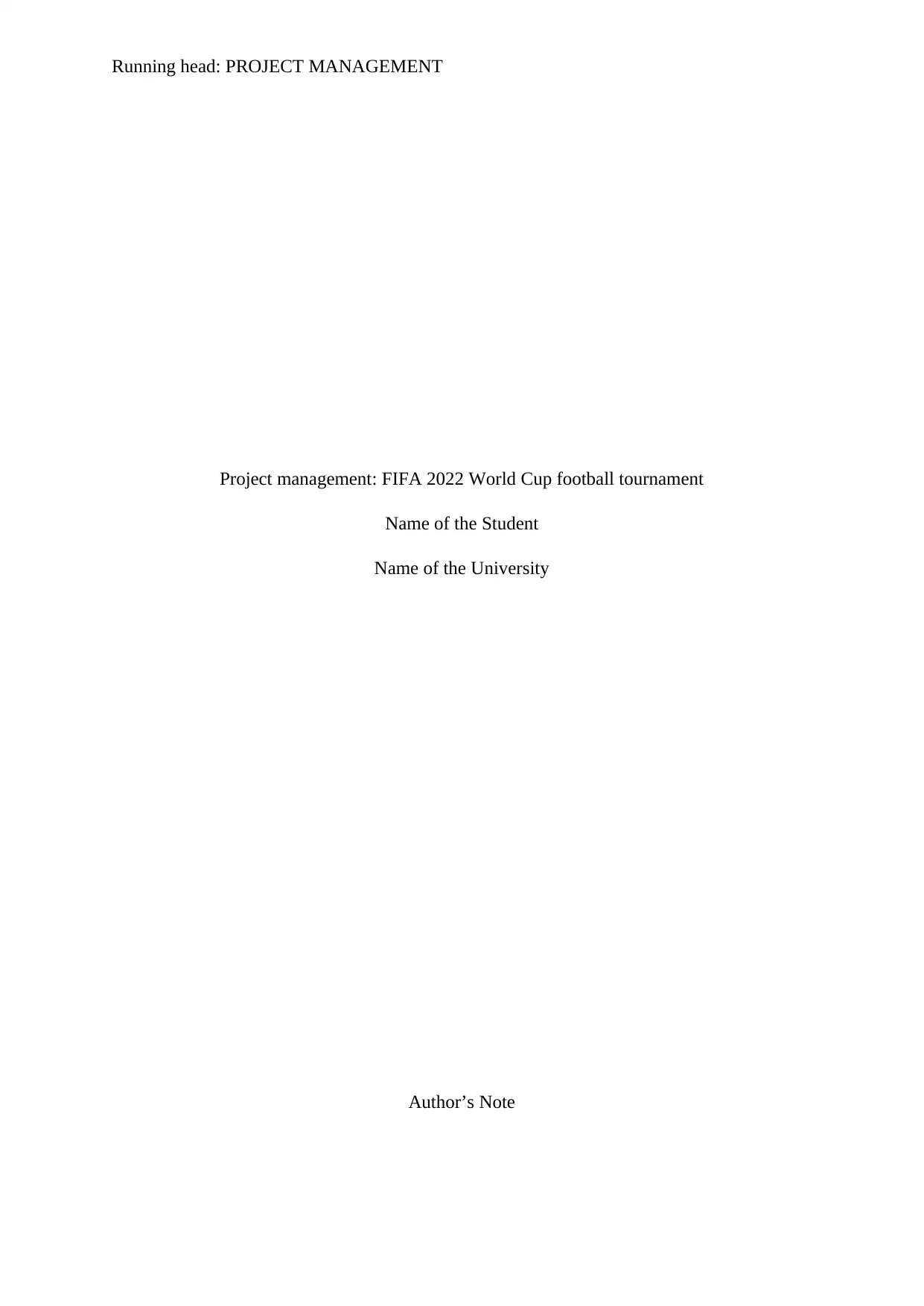
Running head: PROJECT MANAGEMENT
Project management: FIFA 2022 World Cup football tournament
Name of the Student
Name of the University
Author’s Note
Project management: FIFA 2022 World Cup football tournament
Name of the Student
Name of the University
Author’s Note
Paraphrase This Document
Need a fresh take? Get an instant paraphrase of this document with our AI Paraphraser
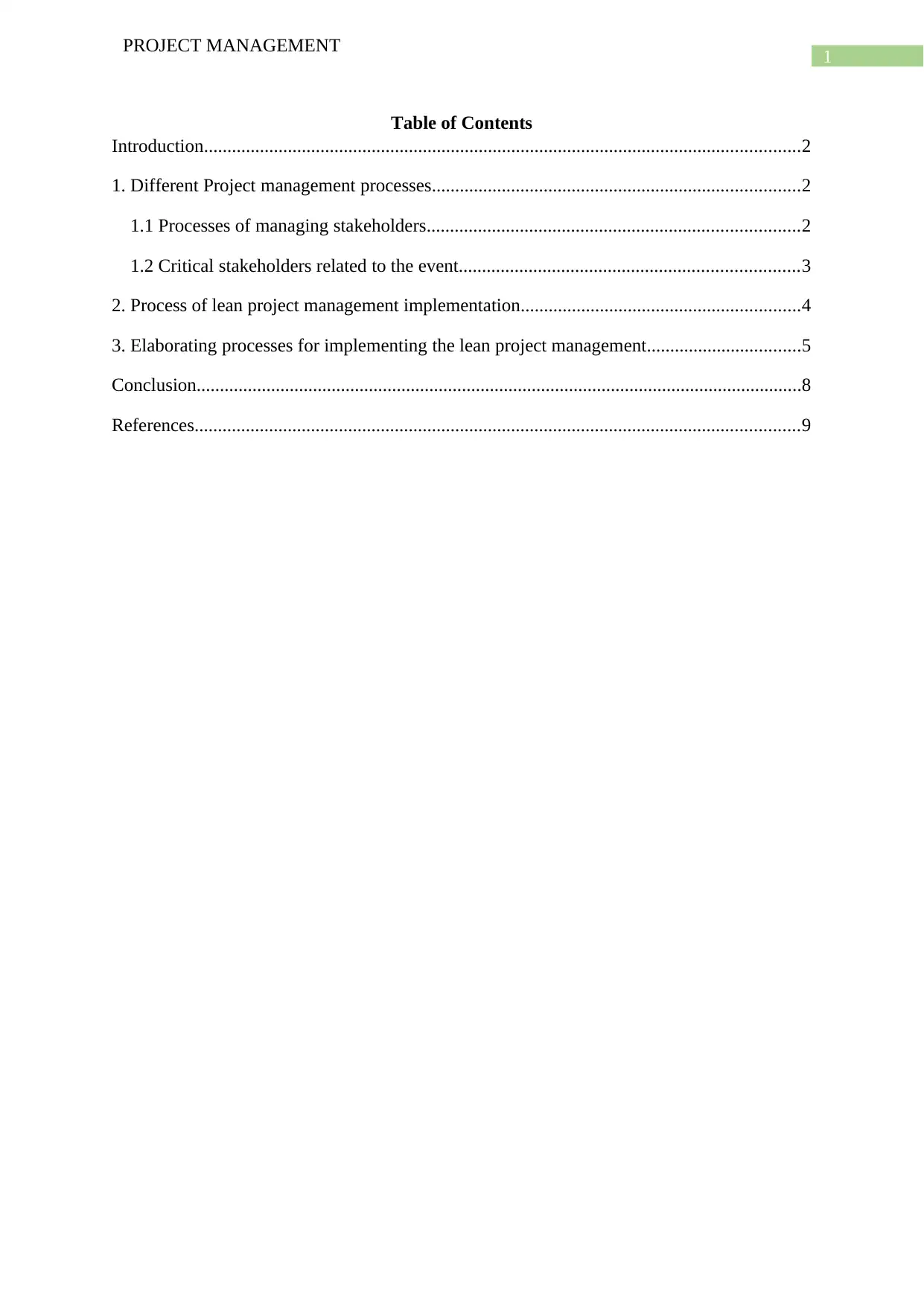
1
PROJECT MANAGEMENT
Table of Contents
Introduction................................................................................................................................2
1. Different Project management processes...............................................................................2
1.1 Processes of managing stakeholders................................................................................2
1.2 Critical stakeholders related to the event.........................................................................3
2. Process of lean project management implementation............................................................4
3. Elaborating processes for implementing the lean project management.................................5
Conclusion..................................................................................................................................8
References..................................................................................................................................9
PROJECT MANAGEMENT
Table of Contents
Introduction................................................................................................................................2
1. Different Project management processes...............................................................................2
1.1 Processes of managing stakeholders................................................................................2
1.2 Critical stakeholders related to the event.........................................................................3
2. Process of lean project management implementation............................................................4
3. Elaborating processes for implementing the lean project management.................................5
Conclusion..................................................................................................................................8
References..................................................................................................................................9
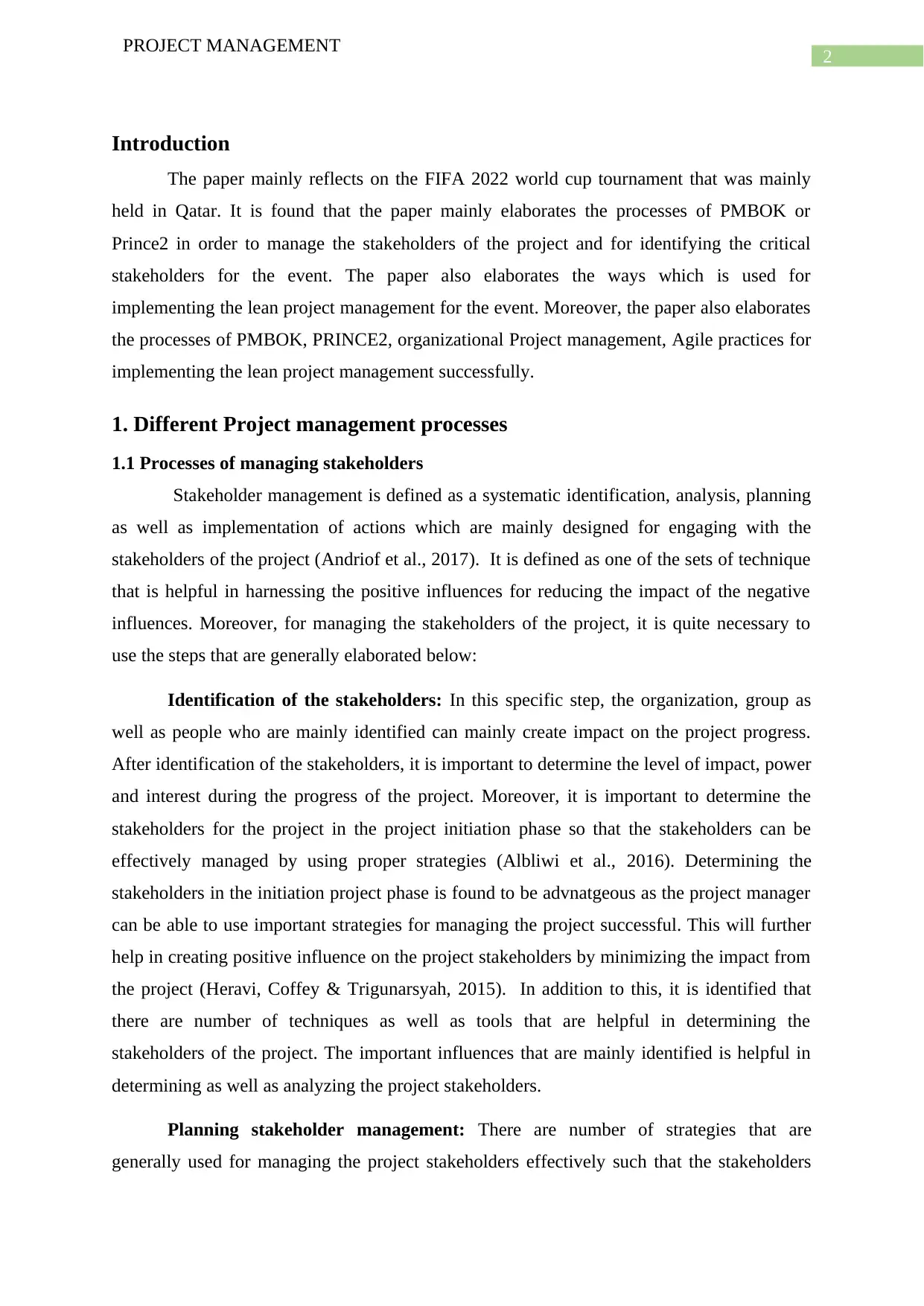
2
PROJECT MANAGEMENT
Introduction
The paper mainly reflects on the FIFA 2022 world cup tournament that was mainly
held in Qatar. It is found that the paper mainly elaborates the processes of PMBOK or
Prince2 in order to manage the stakeholders of the project and for identifying the critical
stakeholders for the event. The paper also elaborates the ways which is used for
implementing the lean project management for the event. Moreover, the paper also elaborates
the processes of PMBOK, PRINCE2, organizational Project management, Agile practices for
implementing the lean project management successfully.
1. Different Project management processes
1.1 Processes of managing stakeholders
Stakeholder management is defined as a systematic identification, analysis, planning
as well as implementation of actions which are mainly designed for engaging with the
stakeholders of the project (Andriof et al., 2017). It is defined as one of the sets of technique
that is helpful in harnessing the positive influences for reducing the impact of the negative
influences. Moreover, for managing the stakeholders of the project, it is quite necessary to
use the steps that are generally elaborated below:
Identification of the stakeholders: In this specific step, the organization, group as
well as people who are mainly identified can mainly create impact on the project progress.
After identification of the stakeholders, it is important to determine the level of impact, power
and interest during the progress of the project. Moreover, it is important to determine the
stakeholders for the project in the project initiation phase so that the stakeholders can be
effectively managed by using proper strategies (Albliwi et al., 2016). Determining the
stakeholders in the initiation project phase is found to be advnatgeous as the project manager
can be able to use important strategies for managing the project successful. This will further
help in creating positive influence on the project stakeholders by minimizing the impact from
the project (Heravi, Coffey & Trigunarsyah, 2015). In addition to this, it is identified that
there are number of techniques as well as tools that are helpful in determining the
stakeholders of the project. The important influences that are mainly identified is helpful in
determining as well as analyzing the project stakeholders.
Planning stakeholder management: There are number of strategies that are
generally used for managing the project stakeholders effectively such that the stakeholders
PROJECT MANAGEMENT
Introduction
The paper mainly reflects on the FIFA 2022 world cup tournament that was mainly
held in Qatar. It is found that the paper mainly elaborates the processes of PMBOK or
Prince2 in order to manage the stakeholders of the project and for identifying the critical
stakeholders for the event. The paper also elaborates the ways which is used for
implementing the lean project management for the event. Moreover, the paper also elaborates
the processes of PMBOK, PRINCE2, organizational Project management, Agile practices for
implementing the lean project management successfully.
1. Different Project management processes
1.1 Processes of managing stakeholders
Stakeholder management is defined as a systematic identification, analysis, planning
as well as implementation of actions which are mainly designed for engaging with the
stakeholders of the project (Andriof et al., 2017). It is defined as one of the sets of technique
that is helpful in harnessing the positive influences for reducing the impact of the negative
influences. Moreover, for managing the stakeholders of the project, it is quite necessary to
use the steps that are generally elaborated below:
Identification of the stakeholders: In this specific step, the organization, group as
well as people who are mainly identified can mainly create impact on the project progress.
After identification of the stakeholders, it is important to determine the level of impact, power
and interest during the progress of the project. Moreover, it is important to determine the
stakeholders for the project in the project initiation phase so that the stakeholders can be
effectively managed by using proper strategies (Albliwi et al., 2016). Determining the
stakeholders in the initiation project phase is found to be advnatgeous as the project manager
can be able to use important strategies for managing the project successful. This will further
help in creating positive influence on the project stakeholders by minimizing the impact from
the project (Heravi, Coffey & Trigunarsyah, 2015). In addition to this, it is identified that
there are number of techniques as well as tools that are helpful in determining the
stakeholders of the project. The important influences that are mainly identified is helpful in
determining as well as analyzing the project stakeholders.
Planning stakeholder management: There are number of strategies that are
generally used for managing the project stakeholders effectively such that the stakeholders
⊘ This is a preview!⊘
Do you want full access?
Subscribe today to unlock all pages.

Trusted by 1+ million students worldwide
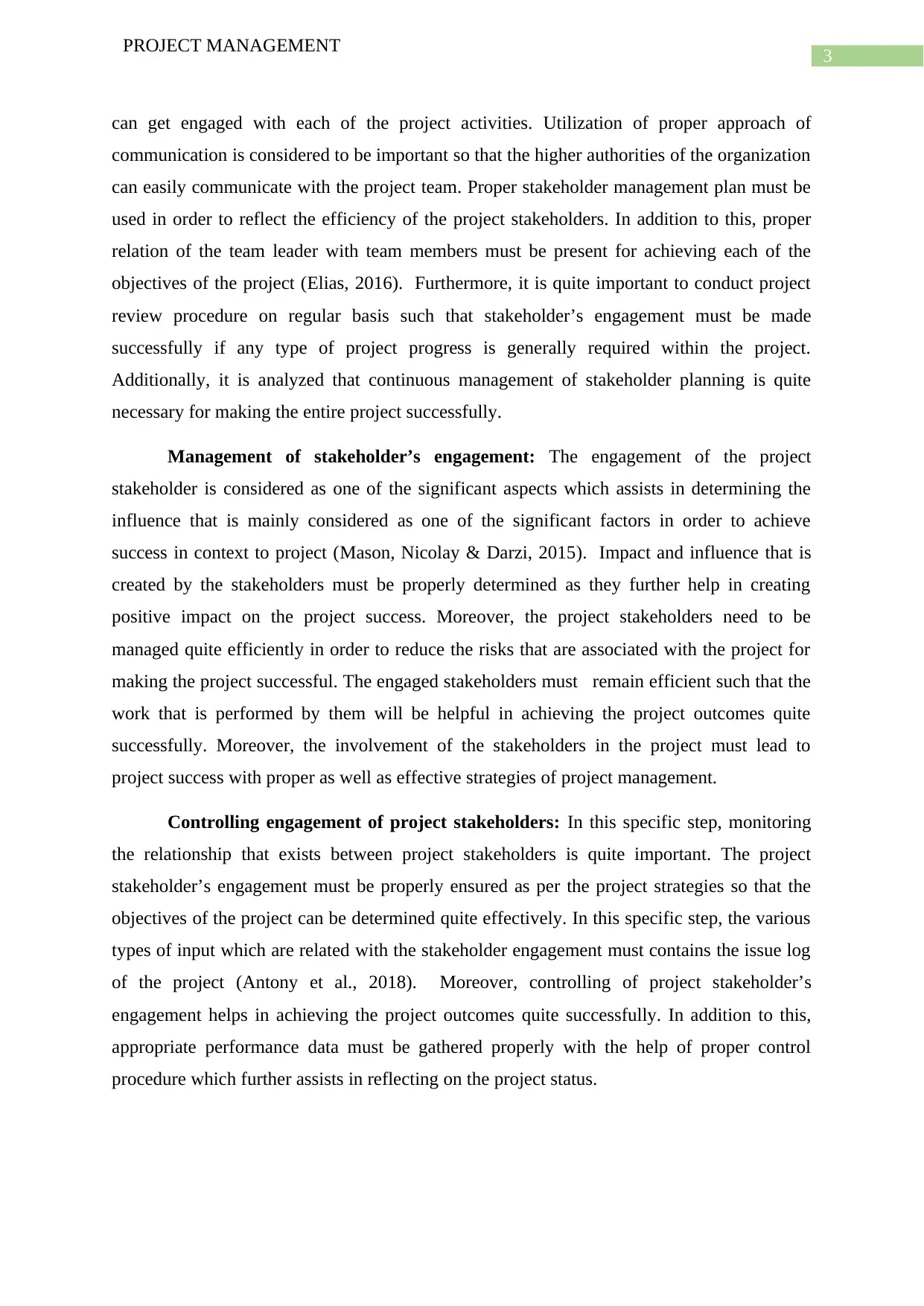
3
PROJECT MANAGEMENT
can get engaged with each of the project activities. Utilization of proper approach of
communication is considered to be important so that the higher authorities of the organization
can easily communicate with the project team. Proper stakeholder management plan must be
used in order to reflect the efficiency of the project stakeholders. In addition to this, proper
relation of the team leader with team members must be present for achieving each of the
objectives of the project (Elias, 2016). Furthermore, it is quite important to conduct project
review procedure on regular basis such that stakeholder’s engagement must be made
successfully if any type of project progress is generally required within the project.
Additionally, it is analyzed that continuous management of stakeholder planning is quite
necessary for making the entire project successfully.
Management of stakeholder’s engagement: The engagement of the project
stakeholder is considered as one of the significant aspects which assists in determining the
influence that is mainly considered as one of the significant factors in order to achieve
success in context to project (Mason, Nicolay & Darzi, 2015). Impact and influence that is
created by the stakeholders must be properly determined as they further help in creating
positive impact on the project success. Moreover, the project stakeholders need to be
managed quite efficiently in order to reduce the risks that are associated with the project for
making the project successful. The engaged stakeholders must remain efficient such that the
work that is performed by them will be helpful in achieving the project outcomes quite
successfully. Moreover, the involvement of the stakeholders in the project must lead to
project success with proper as well as effective strategies of project management.
Controlling engagement of project stakeholders: In this specific step, monitoring
the relationship that exists between project stakeholders is quite important. The project
stakeholder’s engagement must be properly ensured as per the project strategies so that the
objectives of the project can be determined quite effectively. In this specific step, the various
types of input which are related with the stakeholder engagement must contains the issue log
of the project (Antony et al., 2018). Moreover, controlling of project stakeholder’s
engagement helps in achieving the project outcomes quite successfully. In addition to this,
appropriate performance data must be gathered properly with the help of proper control
procedure which further assists in reflecting on the project status.
PROJECT MANAGEMENT
can get engaged with each of the project activities. Utilization of proper approach of
communication is considered to be important so that the higher authorities of the organization
can easily communicate with the project team. Proper stakeholder management plan must be
used in order to reflect the efficiency of the project stakeholders. In addition to this, proper
relation of the team leader with team members must be present for achieving each of the
objectives of the project (Elias, 2016). Furthermore, it is quite important to conduct project
review procedure on regular basis such that stakeholder’s engagement must be made
successfully if any type of project progress is generally required within the project.
Additionally, it is analyzed that continuous management of stakeholder planning is quite
necessary for making the entire project successfully.
Management of stakeholder’s engagement: The engagement of the project
stakeholder is considered as one of the significant aspects which assists in determining the
influence that is mainly considered as one of the significant factors in order to achieve
success in context to project (Mason, Nicolay & Darzi, 2015). Impact and influence that is
created by the stakeholders must be properly determined as they further help in creating
positive impact on the project success. Moreover, the project stakeholders need to be
managed quite efficiently in order to reduce the risks that are associated with the project for
making the project successful. The engaged stakeholders must remain efficient such that the
work that is performed by them will be helpful in achieving the project outcomes quite
successfully. Moreover, the involvement of the stakeholders in the project must lead to
project success with proper as well as effective strategies of project management.
Controlling engagement of project stakeholders: In this specific step, monitoring
the relationship that exists between project stakeholders is quite important. The project
stakeholder’s engagement must be properly ensured as per the project strategies so that the
objectives of the project can be determined quite effectively. In this specific step, the various
types of input which are related with the stakeholder engagement must contains the issue log
of the project (Antony et al., 2018). Moreover, controlling of project stakeholder’s
engagement helps in achieving the project outcomes quite successfully. In addition to this,
appropriate performance data must be gathered properly with the help of proper control
procedure which further assists in reflecting on the project status.
Paraphrase This Document
Need a fresh take? Get an instant paraphrase of this document with our AI Paraphraser
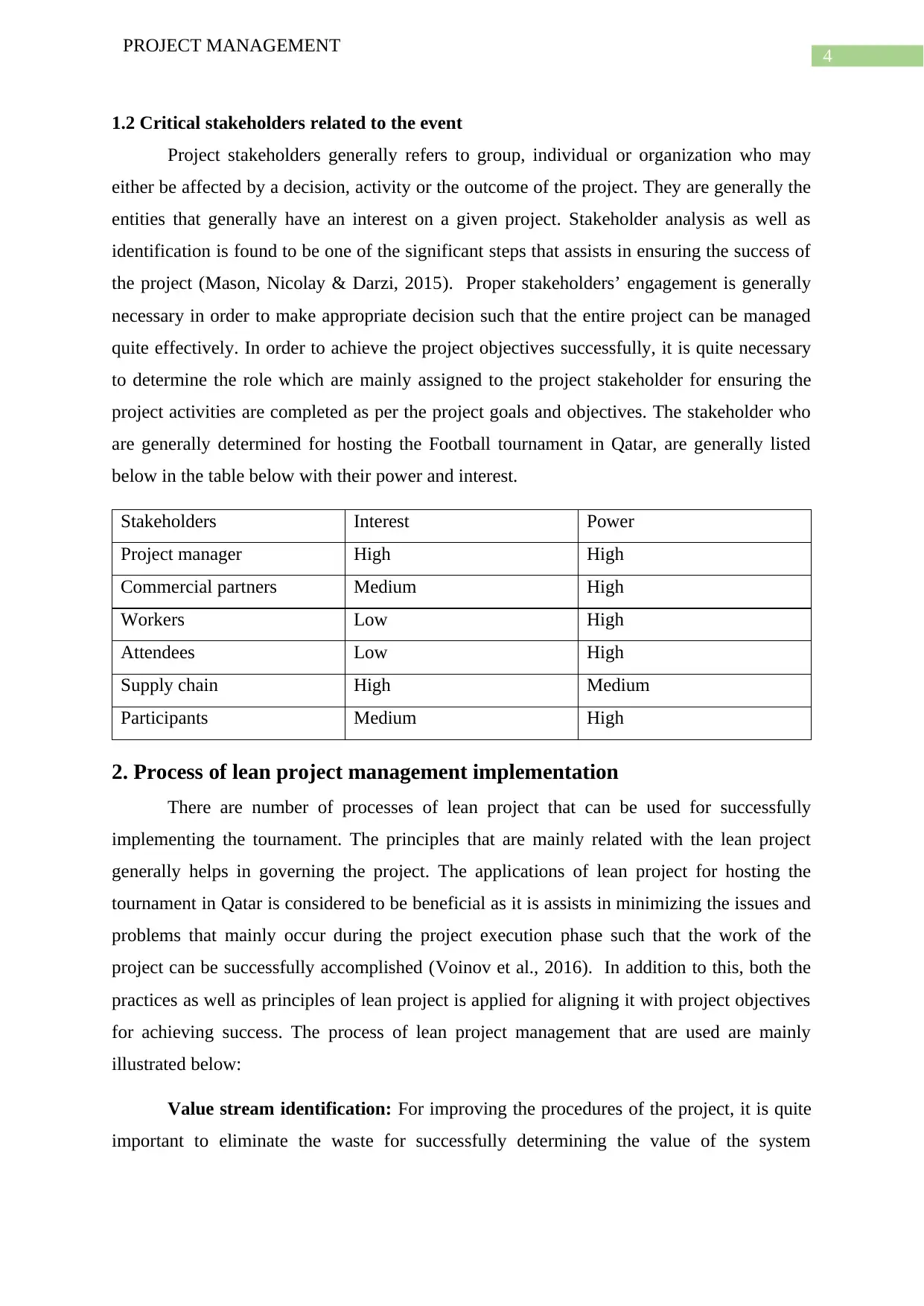
4
PROJECT MANAGEMENT
1.2 Critical stakeholders related to the event
Project stakeholders generally refers to group, individual or organization who may
either be affected by a decision, activity or the outcome of the project. They are generally the
entities that generally have an interest on a given project. Stakeholder analysis as well as
identification is found to be one of the significant steps that assists in ensuring the success of
the project (Mason, Nicolay & Darzi, 2015). Proper stakeholders’ engagement is generally
necessary in order to make appropriate decision such that the entire project can be managed
quite effectively. In order to achieve the project objectives successfully, it is quite necessary
to determine the role which are mainly assigned to the project stakeholder for ensuring the
project activities are completed as per the project goals and objectives. The stakeholder who
are generally determined for hosting the Football tournament in Qatar, are generally listed
below in the table below with their power and interest.
Stakeholders Interest Power
Project manager High High
Commercial partners Medium High
Workers Low High
Attendees Low High
Supply chain High Medium
Participants Medium High
2. Process of lean project management implementation
There are number of processes of lean project that can be used for successfully
implementing the tournament. The principles that are mainly related with the lean project
generally helps in governing the project. The applications of lean project for hosting the
tournament in Qatar is considered to be beneficial as it is assists in minimizing the issues and
problems that mainly occur during the project execution phase such that the work of the
project can be successfully accomplished (Voinov et al., 2016). In addition to this, both the
practices as well as principles of lean project is applied for aligning it with project objectives
for achieving success. The process of lean project management that are used are mainly
illustrated below:
Value stream identification: For improving the procedures of the project, it is quite
important to eliminate the waste for successfully determining the value of the system
PROJECT MANAGEMENT
1.2 Critical stakeholders related to the event
Project stakeholders generally refers to group, individual or organization who may
either be affected by a decision, activity or the outcome of the project. They are generally the
entities that generally have an interest on a given project. Stakeholder analysis as well as
identification is found to be one of the significant steps that assists in ensuring the success of
the project (Mason, Nicolay & Darzi, 2015). Proper stakeholders’ engagement is generally
necessary in order to make appropriate decision such that the entire project can be managed
quite effectively. In order to achieve the project objectives successfully, it is quite necessary
to determine the role which are mainly assigned to the project stakeholder for ensuring the
project activities are completed as per the project goals and objectives. The stakeholder who
are generally determined for hosting the Football tournament in Qatar, are generally listed
below in the table below with their power and interest.
Stakeholders Interest Power
Project manager High High
Commercial partners Medium High
Workers Low High
Attendees Low High
Supply chain High Medium
Participants Medium High
2. Process of lean project management implementation
There are number of processes of lean project that can be used for successfully
implementing the tournament. The principles that are mainly related with the lean project
generally helps in governing the project. The applications of lean project for hosting the
tournament in Qatar is considered to be beneficial as it is assists in minimizing the issues and
problems that mainly occur during the project execution phase such that the work of the
project can be successfully accomplished (Voinov et al., 2016). In addition to this, both the
practices as well as principles of lean project is applied for aligning it with project objectives
for achieving success. The process of lean project management that are used are mainly
illustrated below:
Value stream identification: For improving the procedures of the project, it is quite
important to eliminate the waste for successfully determining the value of the system
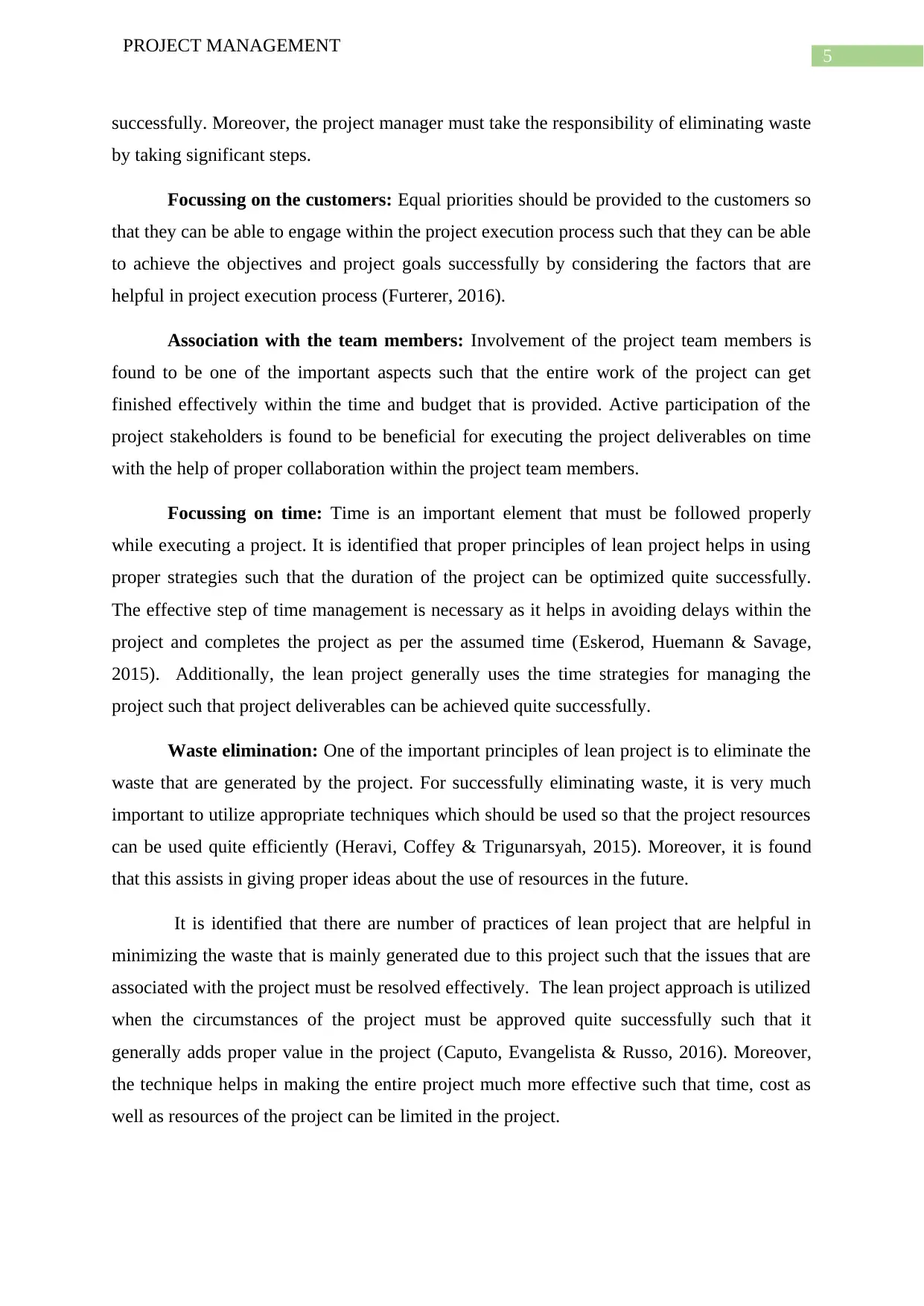
5
PROJECT MANAGEMENT
successfully. Moreover, the project manager must take the responsibility of eliminating waste
by taking significant steps.
Focussing on the customers: Equal priorities should be provided to the customers so
that they can be able to engage within the project execution process such that they can be able
to achieve the objectives and project goals successfully by considering the factors that are
helpful in project execution process (Furterer, 2016).
Association with the team members: Involvement of the project team members is
found to be one of the important aspects such that the entire work of the project can get
finished effectively within the time and budget that is provided. Active participation of the
project stakeholders is found to be beneficial for executing the project deliverables on time
with the help of proper collaboration within the project team members.
Focussing on time: Time is an important element that must be followed properly
while executing a project. It is identified that proper principles of lean project helps in using
proper strategies such that the duration of the project can be optimized quite successfully.
The effective step of time management is necessary as it helps in avoiding delays within the
project and completes the project as per the assumed time (Eskerod, Huemann & Savage,
2015). Additionally, the lean project generally uses the time strategies for managing the
project such that project deliverables can be achieved quite successfully.
Waste elimination: One of the important principles of lean project is to eliminate the
waste that are generated by the project. For successfully eliminating waste, it is very much
important to utilize appropriate techniques which should be used so that the project resources
can be used quite efficiently (Heravi, Coffey & Trigunarsyah, 2015). Moreover, it is found
that this assists in giving proper ideas about the use of resources in the future.
It is identified that there are number of practices of lean project that are helpful in
minimizing the waste that is mainly generated due to this project such that the issues that are
associated with the project must be resolved effectively. The lean project approach is utilized
when the circumstances of the project must be approved quite successfully such that it
generally adds proper value in the project (Caputo, Evangelista & Russo, 2016). Moreover,
the technique helps in making the entire project much more effective such that time, cost as
well as resources of the project can be limited in the project.
PROJECT MANAGEMENT
successfully. Moreover, the project manager must take the responsibility of eliminating waste
by taking significant steps.
Focussing on the customers: Equal priorities should be provided to the customers so
that they can be able to engage within the project execution process such that they can be able
to achieve the objectives and project goals successfully by considering the factors that are
helpful in project execution process (Furterer, 2016).
Association with the team members: Involvement of the project team members is
found to be one of the important aspects such that the entire work of the project can get
finished effectively within the time and budget that is provided. Active participation of the
project stakeholders is found to be beneficial for executing the project deliverables on time
with the help of proper collaboration within the project team members.
Focussing on time: Time is an important element that must be followed properly
while executing a project. It is identified that proper principles of lean project helps in using
proper strategies such that the duration of the project can be optimized quite successfully.
The effective step of time management is necessary as it helps in avoiding delays within the
project and completes the project as per the assumed time (Eskerod, Huemann & Savage,
2015). Additionally, the lean project generally uses the time strategies for managing the
project such that project deliverables can be achieved quite successfully.
Waste elimination: One of the important principles of lean project is to eliminate the
waste that are generated by the project. For successfully eliminating waste, it is very much
important to utilize appropriate techniques which should be used so that the project resources
can be used quite efficiently (Heravi, Coffey & Trigunarsyah, 2015). Moreover, it is found
that this assists in giving proper ideas about the use of resources in the future.
It is identified that there are number of practices of lean project that are helpful in
minimizing the waste that is mainly generated due to this project such that the issues that are
associated with the project must be resolved effectively. The lean project approach is utilized
when the circumstances of the project must be approved quite successfully such that it
generally adds proper value in the project (Caputo, Evangelista & Russo, 2016). Moreover,
the technique helps in making the entire project much more effective such that time, cost as
well as resources of the project can be limited in the project.
⊘ This is a preview!⊘
Do you want full access?
Subscribe today to unlock all pages.

Trusted by 1+ million students worldwide
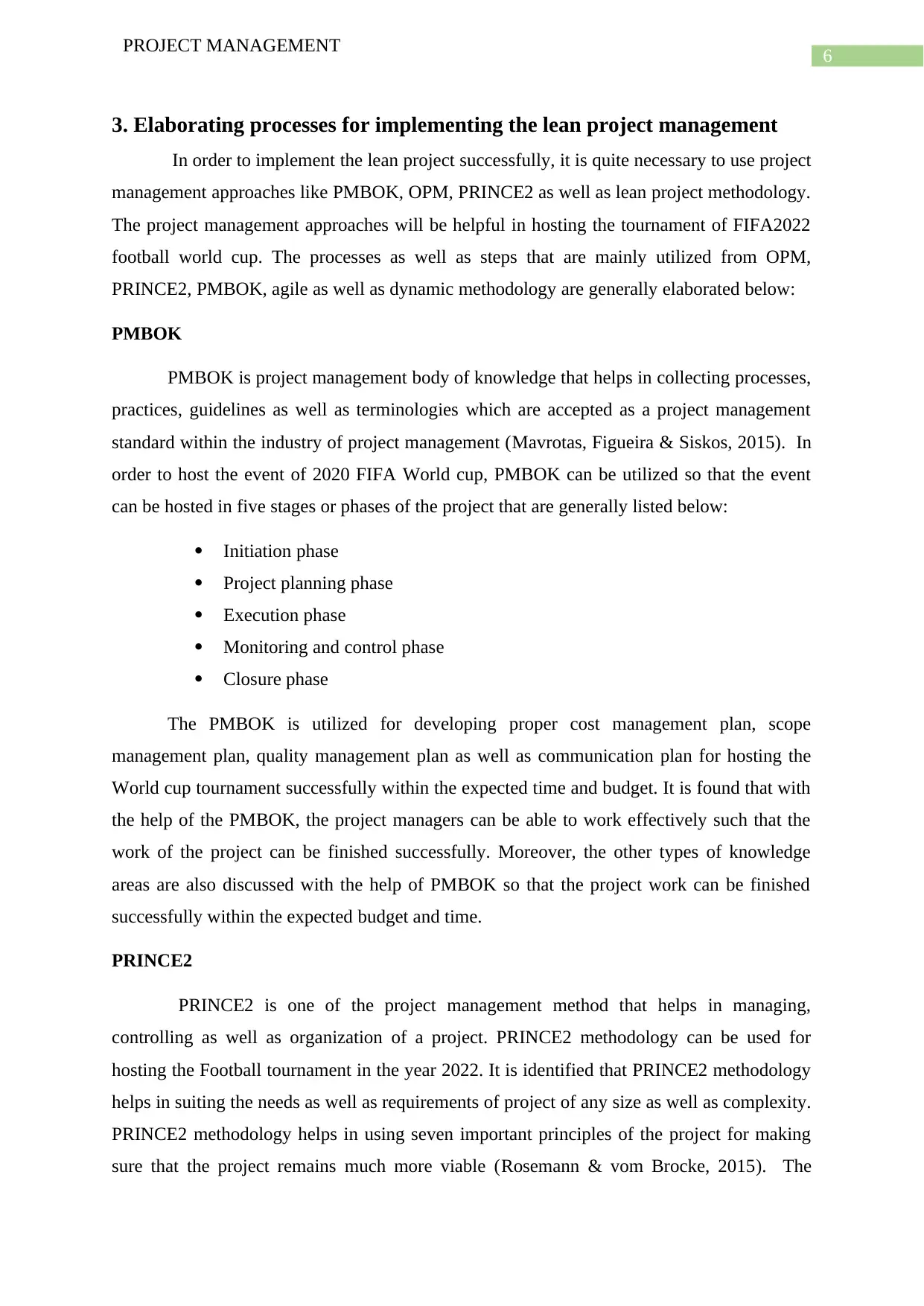
6
PROJECT MANAGEMENT
3. Elaborating processes for implementing the lean project management
In order to implement the lean project successfully, it is quite necessary to use project
management approaches like PMBOK, OPM, PRINCE2 as well as lean project methodology.
The project management approaches will be helpful in hosting the tournament of FIFA2022
football world cup. The processes as well as steps that are mainly utilized from OPM,
PRINCE2, PMBOK, agile as well as dynamic methodology are generally elaborated below:
PMBOK
PMBOK is project management body of knowledge that helps in collecting processes,
practices, guidelines as well as terminologies which are accepted as a project management
standard within the industry of project management (Mavrotas, Figueira & Siskos, 2015). In
order to host the event of 2020 FIFA World cup, PMBOK can be utilized so that the event
can be hosted in five stages or phases of the project that are generally listed below:
Initiation phase
Project planning phase
Execution phase
Monitoring and control phase
Closure phase
The PMBOK is utilized for developing proper cost management plan, scope
management plan, quality management plan as well as communication plan for hosting the
World cup tournament successfully within the expected time and budget. It is found that with
the help of the PMBOK, the project managers can be able to work effectively such that the
work of the project can be finished successfully. Moreover, the other types of knowledge
areas are also discussed with the help of PMBOK so that the project work can be finished
successfully within the expected budget and time.
PRINCE2
PRINCE2 is one of the project management method that helps in managing,
controlling as well as organization of a project. PRINCE2 methodology can be used for
hosting the Football tournament in the year 2022. It is identified that PRINCE2 methodology
helps in suiting the needs as well as requirements of project of any size as well as complexity.
PRINCE2 methodology helps in using seven important principles of the project for making
sure that the project remains much more viable (Rosemann & vom Brocke, 2015). The
PROJECT MANAGEMENT
3. Elaborating processes for implementing the lean project management
In order to implement the lean project successfully, it is quite necessary to use project
management approaches like PMBOK, OPM, PRINCE2 as well as lean project methodology.
The project management approaches will be helpful in hosting the tournament of FIFA2022
football world cup. The processes as well as steps that are mainly utilized from OPM,
PRINCE2, PMBOK, agile as well as dynamic methodology are generally elaborated below:
PMBOK
PMBOK is project management body of knowledge that helps in collecting processes,
practices, guidelines as well as terminologies which are accepted as a project management
standard within the industry of project management (Mavrotas, Figueira & Siskos, 2015). In
order to host the event of 2020 FIFA World cup, PMBOK can be utilized so that the event
can be hosted in five stages or phases of the project that are generally listed below:
Initiation phase
Project planning phase
Execution phase
Monitoring and control phase
Closure phase
The PMBOK is utilized for developing proper cost management plan, scope
management plan, quality management plan as well as communication plan for hosting the
World cup tournament successfully within the expected time and budget. It is found that with
the help of the PMBOK, the project managers can be able to work effectively such that the
work of the project can be finished successfully. Moreover, the other types of knowledge
areas are also discussed with the help of PMBOK so that the project work can be finished
successfully within the expected budget and time.
PRINCE2
PRINCE2 is one of the project management method that helps in managing,
controlling as well as organization of a project. PRINCE2 methodology can be used for
hosting the Football tournament in the year 2022. It is identified that PRINCE2 methodology
helps in suiting the needs as well as requirements of project of any size as well as complexity.
PRINCE2 methodology helps in using seven important principles of the project for making
sure that the project remains much more viable (Rosemann & vom Brocke, 2015). The
Paraphrase This Document
Need a fresh take? Get an instant paraphrase of this document with our AI Paraphraser
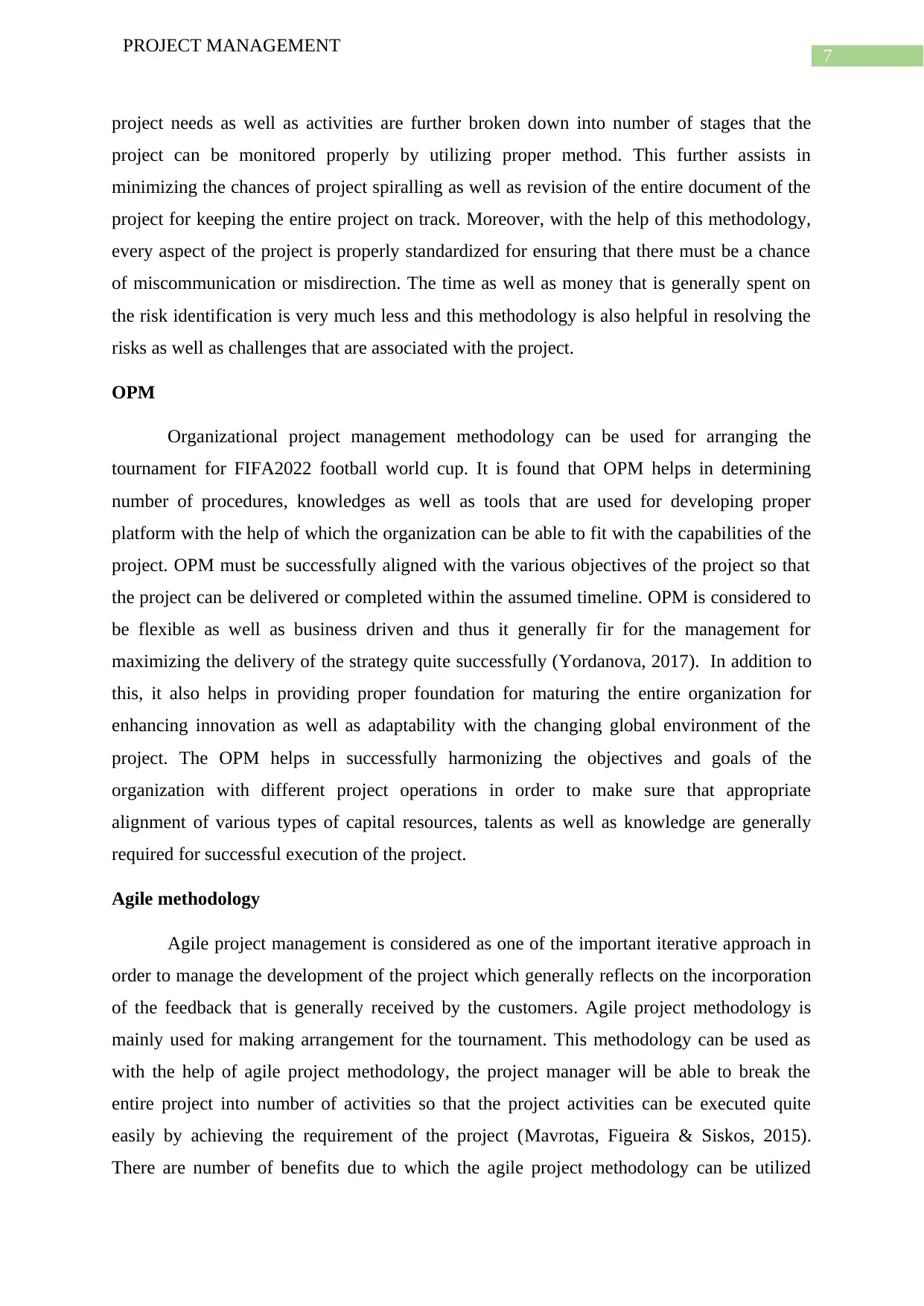
7
PROJECT MANAGEMENT
project needs as well as activities are further broken down into number of stages that the
project can be monitored properly by utilizing proper method. This further assists in
minimizing the chances of project spiralling as well as revision of the entire document of the
project for keeping the entire project on track. Moreover, with the help of this methodology,
every aspect of the project is properly standardized for ensuring that there must be a chance
of miscommunication or misdirection. The time as well as money that is generally spent on
the risk identification is very much less and this methodology is also helpful in resolving the
risks as well as challenges that are associated with the project.
OPM
Organizational project management methodology can be used for arranging the
tournament for FIFA2022 football world cup. It is found that OPM helps in determining
number of procedures, knowledges as well as tools that are used for developing proper
platform with the help of which the organization can be able to fit with the capabilities of the
project. OPM must be successfully aligned with the various objectives of the project so that
the project can be delivered or completed within the assumed timeline. OPM is considered to
be flexible as well as business driven and thus it generally fir for the management for
maximizing the delivery of the strategy quite successfully (Yordanova, 2017). In addition to
this, it also helps in providing proper foundation for maturing the entire organization for
enhancing innovation as well as adaptability with the changing global environment of the
project. The OPM helps in successfully harmonizing the objectives and goals of the
organization with different project operations in order to make sure that appropriate
alignment of various types of capital resources, talents as well as knowledge are generally
required for successful execution of the project.
Agile methodology
Agile project management is considered as one of the important iterative approach in
order to manage the development of the project which generally reflects on the incorporation
of the feedback that is generally received by the customers. Agile project methodology is
mainly used for making arrangement for the tournament. This methodology can be used as
with the help of agile project methodology, the project manager will be able to break the
entire project into number of activities so that the project activities can be executed quite
easily by achieving the requirement of the project (Mavrotas, Figueira & Siskos, 2015).
There are number of benefits due to which the agile project methodology can be utilized
PROJECT MANAGEMENT
project needs as well as activities are further broken down into number of stages that the
project can be monitored properly by utilizing proper method. This further assists in
minimizing the chances of project spiralling as well as revision of the entire document of the
project for keeping the entire project on track. Moreover, with the help of this methodology,
every aspect of the project is properly standardized for ensuring that there must be a chance
of miscommunication or misdirection. The time as well as money that is generally spent on
the risk identification is very much less and this methodology is also helpful in resolving the
risks as well as challenges that are associated with the project.
OPM
Organizational project management methodology can be used for arranging the
tournament for FIFA2022 football world cup. It is found that OPM helps in determining
number of procedures, knowledges as well as tools that are used for developing proper
platform with the help of which the organization can be able to fit with the capabilities of the
project. OPM must be successfully aligned with the various objectives of the project so that
the project can be delivered or completed within the assumed timeline. OPM is considered to
be flexible as well as business driven and thus it generally fir for the management for
maximizing the delivery of the strategy quite successfully (Yordanova, 2017). In addition to
this, it also helps in providing proper foundation for maturing the entire organization for
enhancing innovation as well as adaptability with the changing global environment of the
project. The OPM helps in successfully harmonizing the objectives and goals of the
organization with different project operations in order to make sure that appropriate
alignment of various types of capital resources, talents as well as knowledge are generally
required for successful execution of the project.
Agile methodology
Agile project management is considered as one of the important iterative approach in
order to manage the development of the project which generally reflects on the incorporation
of the feedback that is generally received by the customers. Agile project methodology is
mainly used for making arrangement for the tournament. This methodology can be used as
with the help of agile project methodology, the project manager will be able to break the
entire project into number of activities so that the project activities can be executed quite
easily by achieving the requirement of the project (Mavrotas, Figueira & Siskos, 2015).
There are number of benefits due to which the agile project methodology can be utilized

8
PROJECT MANAGEMENT
within the project. Agile methodology helps in making team much more efficient as the agile
methodology generally works in a very much collaborative culture such that the efficiency of
the project generally helps in developing a ripple factor. In agile, testing is conducted during
the development cycle of the project which is considered to be beneficial, as it helps in
making sure that the delivered product is in its optimum state. Furthermore, it helps in
enabling the owner of the product for performing changes such that the entire team is aware
of various types of potential issues as well as challenges.
Lean Six Sigma
Lean Six sigma is considered as one of the methods that generally depends on the
effort of the collaborative team for improving the performance by systematically removing
the entire waste by minimizing the variation within the entire project. It helps in combing the
manufacturing of lean enterprise and Six sigma for eliminating the waste that is mainly
occurred within the project (Caputo, Evangelista & Russo, 2016). It is considered as one of
the efficient methods that helps in resolving problem as well as assists in reducing the amount
of time that the defective products are generally manufacture and thus it resulted in the
increment of customer satisfaction. Moreover, the waste that will be generated by hosting the
tournament will be minimized if this project methodology will be used. In addition to this,
there are number of benefits of Six sigma and the benefits mainly helps in improving profit
by decreasing cost as well as improving the efficiency as well as effectiveness.
Conclusion
It can be concluded from the entire report that there are number of processes as well
as steps of project management that needs to be used for hosting the FIFA2022 world cup
tournament. It is identified that the waste that is generally developed within the entire project
will be managed quite effectively with the help of lean project. The report discusses the steps
that are helpful in managing the project stakeholders and the critical stakeholders who are
mainly associated with the project. The paper also discusses the steps of lean project that are
helpful in completing the entire project successfully by eliminating the constraint which are
related with the project. Moreover, different processes of project management are generally
discussed in order to use the methodologies for the project.
PROJECT MANAGEMENT
within the project. Agile methodology helps in making team much more efficient as the agile
methodology generally works in a very much collaborative culture such that the efficiency of
the project generally helps in developing a ripple factor. In agile, testing is conducted during
the development cycle of the project which is considered to be beneficial, as it helps in
making sure that the delivered product is in its optimum state. Furthermore, it helps in
enabling the owner of the product for performing changes such that the entire team is aware
of various types of potential issues as well as challenges.
Lean Six Sigma
Lean Six sigma is considered as one of the methods that generally depends on the
effort of the collaborative team for improving the performance by systematically removing
the entire waste by minimizing the variation within the entire project. It helps in combing the
manufacturing of lean enterprise and Six sigma for eliminating the waste that is mainly
occurred within the project (Caputo, Evangelista & Russo, 2016). It is considered as one of
the efficient methods that helps in resolving problem as well as assists in reducing the amount
of time that the defective products are generally manufacture and thus it resulted in the
increment of customer satisfaction. Moreover, the waste that will be generated by hosting the
tournament will be minimized if this project methodology will be used. In addition to this,
there are number of benefits of Six sigma and the benefits mainly helps in improving profit
by decreasing cost as well as improving the efficiency as well as effectiveness.
Conclusion
It can be concluded from the entire report that there are number of processes as well
as steps of project management that needs to be used for hosting the FIFA2022 world cup
tournament. It is identified that the waste that is generally developed within the entire project
will be managed quite effectively with the help of lean project. The report discusses the steps
that are helpful in managing the project stakeholders and the critical stakeholders who are
mainly associated with the project. The paper also discusses the steps of lean project that are
helpful in completing the entire project successfully by eliminating the constraint which are
related with the project. Moreover, different processes of project management are generally
discussed in order to use the methodologies for the project.
⊘ This is a preview!⊘
Do you want full access?
Subscribe today to unlock all pages.

Trusted by 1+ million students worldwide
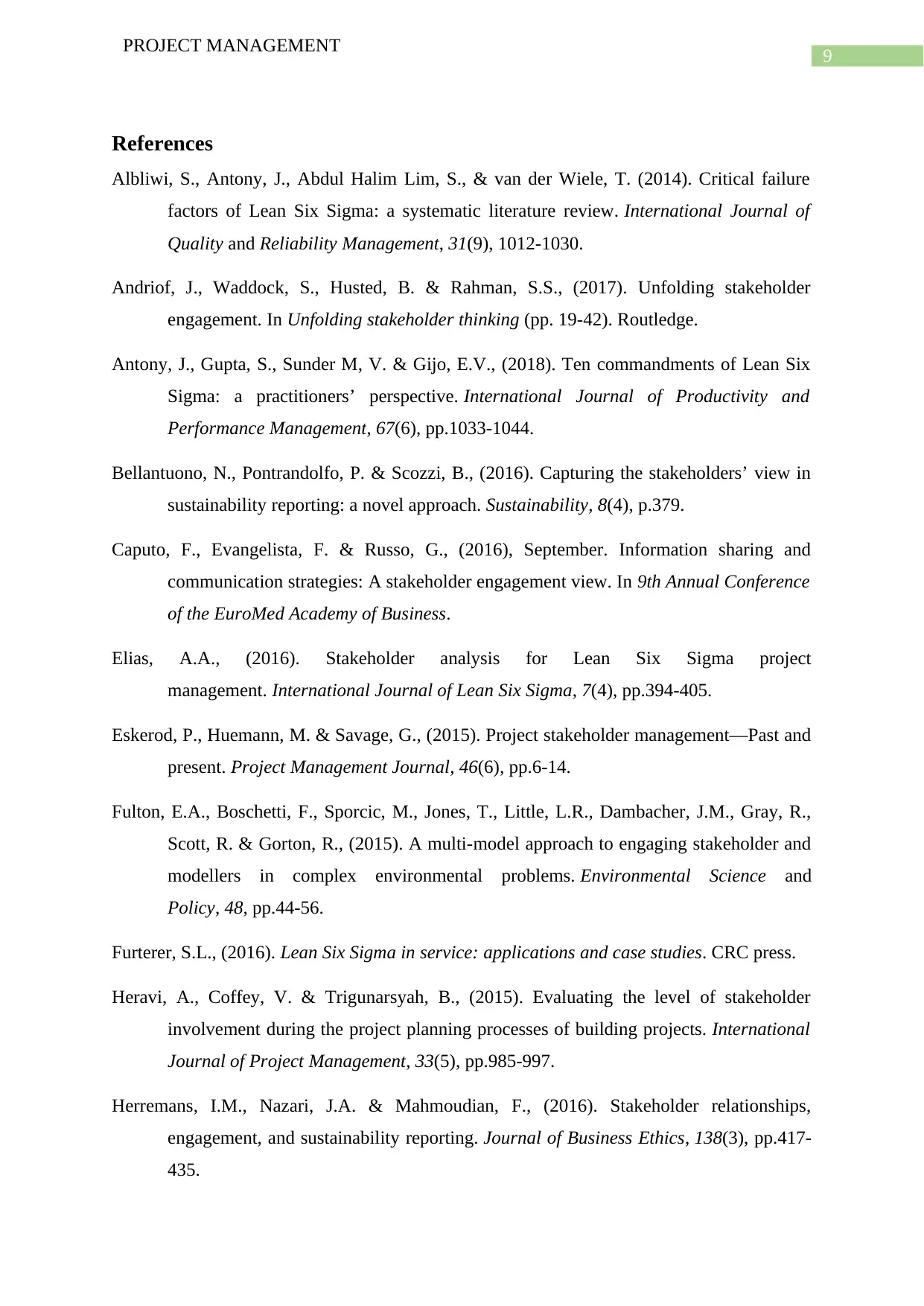
9
PROJECT MANAGEMENT
References
Albliwi, S., Antony, J., Abdul Halim Lim, S., & van der Wiele, T. (2014). Critical failure
factors of Lean Six Sigma: a systematic literature review. International Journal of
Quality and Reliability Management, 31(9), 1012-1030.
Andriof, J., Waddock, S., Husted, B. & Rahman, S.S., (2017). Unfolding stakeholder
engagement. In Unfolding stakeholder thinking (pp. 19-42). Routledge.
Antony, J., Gupta, S., Sunder M, V. & Gijo, E.V., (2018). Ten commandments of Lean Six
Sigma: a practitioners’ perspective. International Journal of Productivity and
Performance Management, 67(6), pp.1033-1044.
Bellantuono, N., Pontrandolfo, P. & Scozzi, B., (2016). Capturing the stakeholders’ view in
sustainability reporting: a novel approach. Sustainability, 8(4), p.379.
Caputo, F., Evangelista, F. & Russo, G., (2016), September. Information sharing and
communication strategies: A stakeholder engagement view. In 9th Annual Conference
of the EuroMed Academy of Business.
Elias, A.A., (2016). Stakeholder analysis for Lean Six Sigma project
management. International Journal of Lean Six Sigma, 7(4), pp.394-405.
Eskerod, P., Huemann, M. & Savage, G., (2015). Project stakeholder management—Past and
present. Project Management Journal, 46(6), pp.6-14.
Fulton, E.A., Boschetti, F., Sporcic, M., Jones, T., Little, L.R., Dambacher, J.M., Gray, R.,
Scott, R. & Gorton, R., (2015). A multi-model approach to engaging stakeholder and
modellers in complex environmental problems. Environmental Science and
Policy, 48, pp.44-56.
Furterer, S.L., (2016). Lean Six Sigma in service: applications and case studies. CRC press.
Heravi, A., Coffey, V. & Trigunarsyah, B., (2015). Evaluating the level of stakeholder
involvement during the project planning processes of building projects. International
Journal of Project Management, 33(5), pp.985-997.
Herremans, I.M., Nazari, J.A. & Mahmoudian, F., (2016). Stakeholder relationships,
engagement, and sustainability reporting. Journal of Business Ethics, 138(3), pp.417-
435.
PROJECT MANAGEMENT
References
Albliwi, S., Antony, J., Abdul Halim Lim, S., & van der Wiele, T. (2014). Critical failure
factors of Lean Six Sigma: a systematic literature review. International Journal of
Quality and Reliability Management, 31(9), 1012-1030.
Andriof, J., Waddock, S., Husted, B. & Rahman, S.S., (2017). Unfolding stakeholder
engagement. In Unfolding stakeholder thinking (pp. 19-42). Routledge.
Antony, J., Gupta, S., Sunder M, V. & Gijo, E.V., (2018). Ten commandments of Lean Six
Sigma: a practitioners’ perspective. International Journal of Productivity and
Performance Management, 67(6), pp.1033-1044.
Bellantuono, N., Pontrandolfo, P. & Scozzi, B., (2016). Capturing the stakeholders’ view in
sustainability reporting: a novel approach. Sustainability, 8(4), p.379.
Caputo, F., Evangelista, F. & Russo, G., (2016), September. Information sharing and
communication strategies: A stakeholder engagement view. In 9th Annual Conference
of the EuroMed Academy of Business.
Elias, A.A., (2016). Stakeholder analysis for Lean Six Sigma project
management. International Journal of Lean Six Sigma, 7(4), pp.394-405.
Eskerod, P., Huemann, M. & Savage, G., (2015). Project stakeholder management—Past and
present. Project Management Journal, 46(6), pp.6-14.
Fulton, E.A., Boschetti, F., Sporcic, M., Jones, T., Little, L.R., Dambacher, J.M., Gray, R.,
Scott, R. & Gorton, R., (2015). A multi-model approach to engaging stakeholder and
modellers in complex environmental problems. Environmental Science and
Policy, 48, pp.44-56.
Furterer, S.L., (2016). Lean Six Sigma in service: applications and case studies. CRC press.
Heravi, A., Coffey, V. & Trigunarsyah, B., (2015). Evaluating the level of stakeholder
involvement during the project planning processes of building projects. International
Journal of Project Management, 33(5), pp.985-997.
Herremans, I.M., Nazari, J.A. & Mahmoudian, F., (2016). Stakeholder relationships,
engagement, and sustainability reporting. Journal of Business Ethics, 138(3), pp.417-
435.
Paraphrase This Document
Need a fresh take? Get an instant paraphrase of this document with our AI Paraphraser
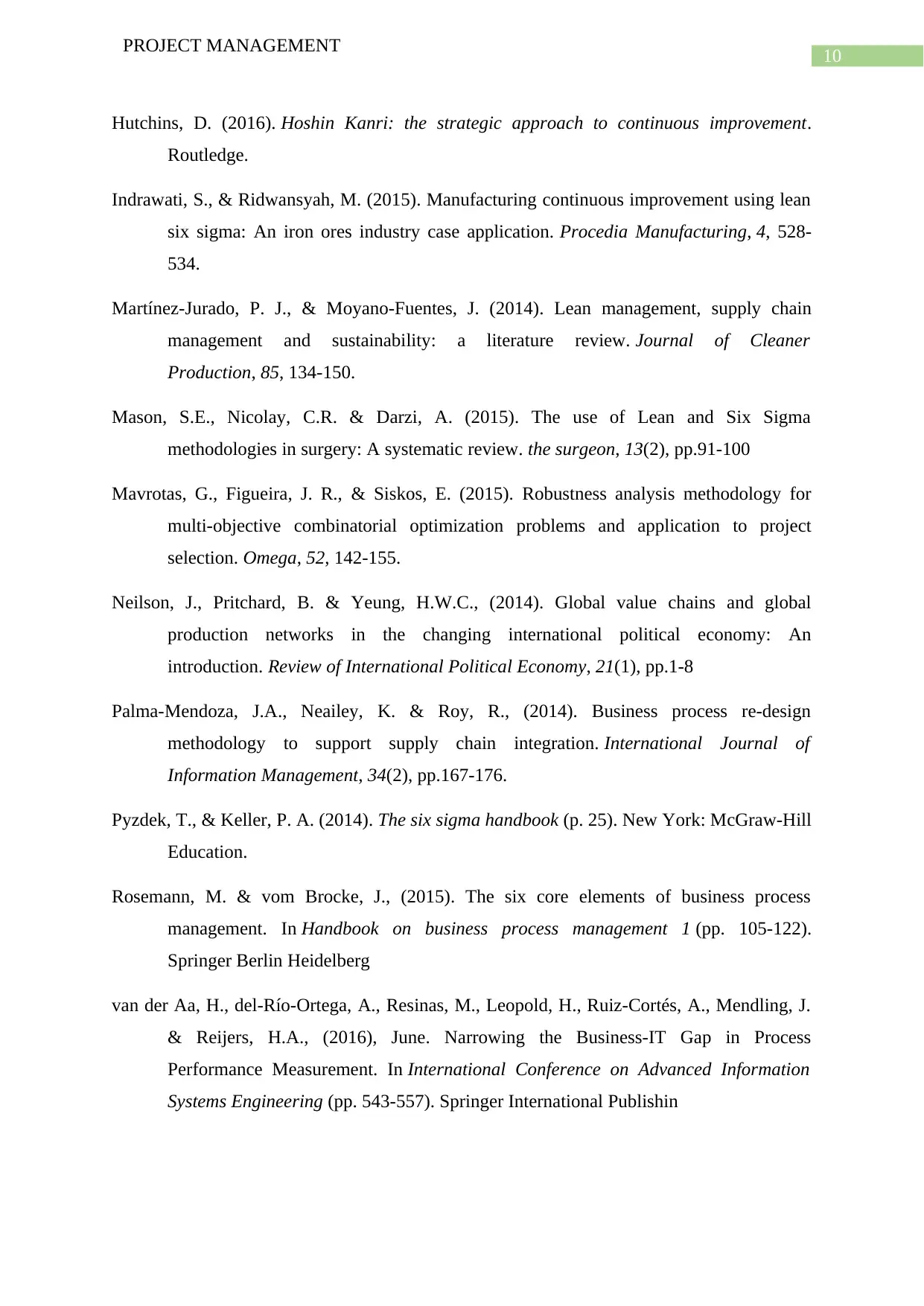
10
PROJECT MANAGEMENT
Hutchins, D. (2016). Hoshin Kanri: the strategic approach to continuous improvement.
Routledge.
Indrawati, S., & Ridwansyah, M. (2015). Manufacturing continuous improvement using lean
six sigma: An iron ores industry case application. Procedia Manufacturing, 4, 528-
534.
Martínez-Jurado, P. J., & Moyano-Fuentes, J. (2014). Lean management, supply chain
management and sustainability: a literature review. Journal of Cleaner
Production, 85, 134-150.
Mason, S.E., Nicolay, C.R. & Darzi, A. (2015). The use of Lean and Six Sigma
methodologies in surgery: A systematic review. the surgeon, 13(2), pp.91-100
Mavrotas, G., Figueira, J. R., & Siskos, E. (2015). Robustness analysis methodology for
multi-objective combinatorial optimization problems and application to project
selection. Omega, 52, 142-155.
Neilson, J., Pritchard, B. & Yeung, H.W.C., (2014). Global value chains and global
production networks in the changing international political economy: An
introduction. Review of International Political Economy, 21(1), pp.1-8
Palma-Mendoza, J.A., Neailey, K. & Roy, R., (2014). Business process re-design
methodology to support supply chain integration. International Journal of
Information Management, 34(2), pp.167-176.
Pyzdek, T., & Keller, P. A. (2014). The six sigma handbook (p. 25). New York: McGraw-Hill
Education.
Rosemann, M. & vom Brocke, J., (2015). The six core elements of business process
management. In Handbook on business process management 1 (pp. 105-122).
Springer Berlin Heidelberg
van der Aa, H., del-Río-Ortega, A., Resinas, M., Leopold, H., Ruiz-Cortés, A., Mendling, J.
& Reijers, H.A., (2016), June. Narrowing the Business-IT Gap in Process
Performance Measurement. In International Conference on Advanced Information
Systems Engineering (pp. 543-557). Springer International Publishin
PROJECT MANAGEMENT
Hutchins, D. (2016). Hoshin Kanri: the strategic approach to continuous improvement.
Routledge.
Indrawati, S., & Ridwansyah, M. (2015). Manufacturing continuous improvement using lean
six sigma: An iron ores industry case application. Procedia Manufacturing, 4, 528-
534.
Martínez-Jurado, P. J., & Moyano-Fuentes, J. (2014). Lean management, supply chain
management and sustainability: a literature review. Journal of Cleaner
Production, 85, 134-150.
Mason, S.E., Nicolay, C.R. & Darzi, A. (2015). The use of Lean and Six Sigma
methodologies in surgery: A systematic review. the surgeon, 13(2), pp.91-100
Mavrotas, G., Figueira, J. R., & Siskos, E. (2015). Robustness analysis methodology for
multi-objective combinatorial optimization problems and application to project
selection. Omega, 52, 142-155.
Neilson, J., Pritchard, B. & Yeung, H.W.C., (2014). Global value chains and global
production networks in the changing international political economy: An
introduction. Review of International Political Economy, 21(1), pp.1-8
Palma-Mendoza, J.A., Neailey, K. & Roy, R., (2014). Business process re-design
methodology to support supply chain integration. International Journal of
Information Management, 34(2), pp.167-176.
Pyzdek, T., & Keller, P. A. (2014). The six sigma handbook (p. 25). New York: McGraw-Hill
Education.
Rosemann, M. & vom Brocke, J., (2015). The six core elements of business process
management. In Handbook on business process management 1 (pp. 105-122).
Springer Berlin Heidelberg
van der Aa, H., del-Río-Ortega, A., Resinas, M., Leopold, H., Ruiz-Cortés, A., Mendling, J.
& Reijers, H.A., (2016), June. Narrowing the Business-IT Gap in Process
Performance Measurement. In International Conference on Advanced Information
Systems Engineering (pp. 543-557). Springer International Publishin
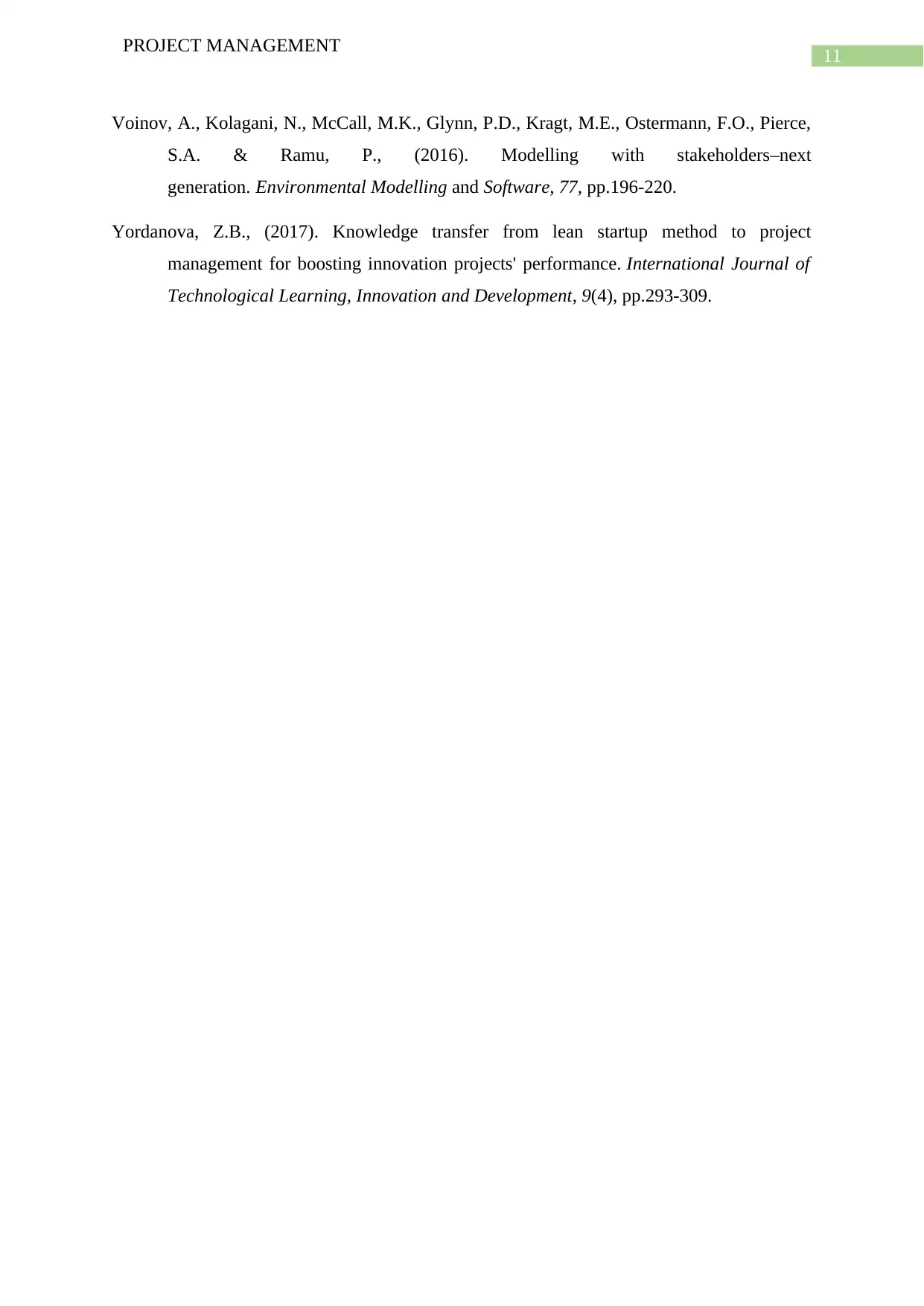
11
PROJECT MANAGEMENT
Voinov, A., Kolagani, N., McCall, M.K., Glynn, P.D., Kragt, M.E., Ostermann, F.O., Pierce,
S.A. & Ramu, P., (2016). Modelling with stakeholders–next
generation. Environmental Modelling and Software, 77, pp.196-220.
Yordanova, Z.B., (2017). Knowledge transfer from lean startup method to project
management for boosting innovation projects' performance. International Journal of
Technological Learning, Innovation and Development, 9(4), pp.293-309.
PROJECT MANAGEMENT
Voinov, A., Kolagani, N., McCall, M.K., Glynn, P.D., Kragt, M.E., Ostermann, F.O., Pierce,
S.A. & Ramu, P., (2016). Modelling with stakeholders–next
generation. Environmental Modelling and Software, 77, pp.196-220.
Yordanova, Z.B., (2017). Knowledge transfer from lean startup method to project
management for boosting innovation projects' performance. International Journal of
Technological Learning, Innovation and Development, 9(4), pp.293-309.
⊘ This is a preview!⊘
Do you want full access?
Subscribe today to unlock all pages.

Trusted by 1+ million students worldwide
1 out of 12
Related Documents
Your All-in-One AI-Powered Toolkit for Academic Success.
+13062052269
info@desklib.com
Available 24*7 on WhatsApp / Email
![[object Object]](/_next/static/media/star-bottom.7253800d.svg)
Unlock your academic potential
Copyright © 2020–2025 A2Z Services. All Rights Reserved. Developed and managed by ZUCOL.





